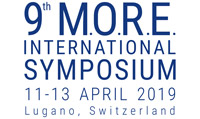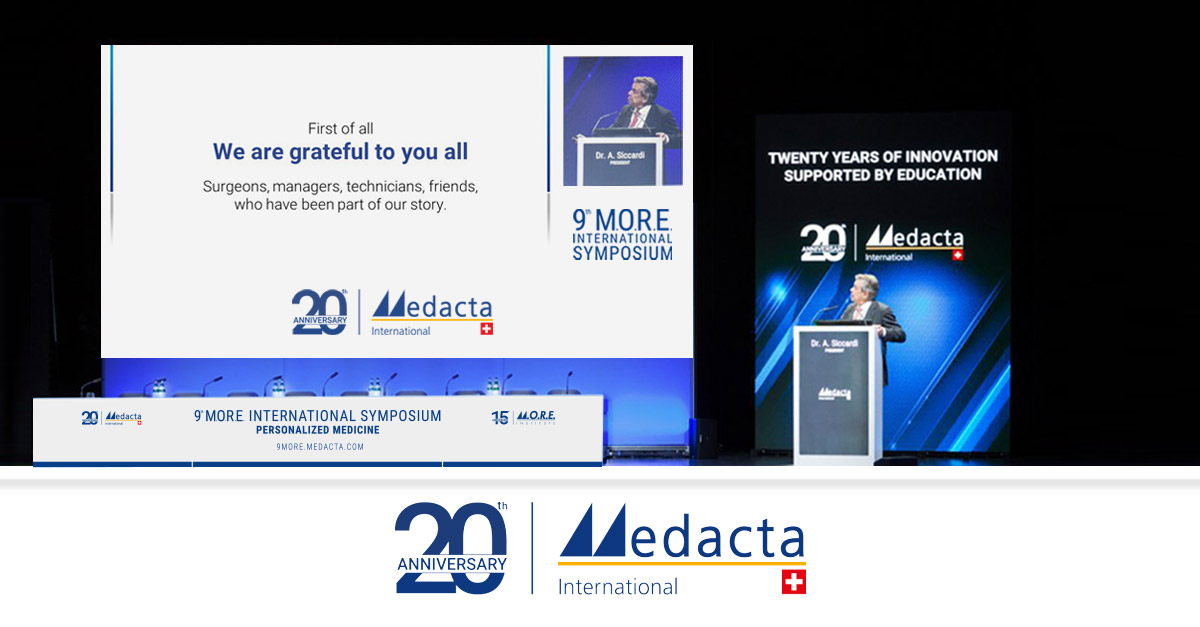Medacta and the
M.O.R.E. Institute welcomed 1,500 attendees from all over the world. Besides
joint and
spine sessions, the symposium – for the first time – included sessions focused on shoulder, knee and hip treatments for
sports medicine. More than 120 orthopaedic experts presented at the meeting, including keynote speakers
Bernhard Jost (Switzerland) and
Douglas Padgett (U.S.) for joints;
Matthias Zumstein (Switzerland) for sports medicine; and
Paul Heini (Switzerland) and
Klaus Radermacher (Germany) for spine. The event took place in the Lugano Convention Center (Joint and Sports Medicine sessions) and in the Exhibition Center Lugano - Conza Pavilion (Spine sessions).
“As we launch into our 20th year, we reinforce that Medacta was built on the belief that innovation and continuous surgeon education can and will improve a patient’s experience in orthopaedics and positively impact overall healthcare sustainability,” said Francesco Siccardi, Chief Executive Officer of Medacta International. “We are thrilled to host orthopaedic surgeons from all over the world as we seek to amplify international discourse concerning personalized solutions for patients seeking pain relief in all areas of orthopaedic care.”
During the 9
th M.O.R.E. International Symposium, Medacta also celebrated the 15
th anniversary of the
M.O.R.E. (Medacta Orthopaedic Research and Education) Institute. The M.O.R.E. Institute was created to provide continuous support to professionals in the field of research and education and improve patient outcomes with the most effective and tailor-made training programs for surgeons, surgeon to surgeon educational opportunities and the opportunity to share experience.
During the symposium Medacta displayed its proprietary augmented reality platform, which has the aim of potentially improving efficiency and precision in computer-assisted surgery and delivering personalized planning. Another innovative development that was shown during the congress is the robotic leg positioner for use in AMIS procedures that enhances surgeon precision and control during surgery.
Twenty-five sessions have taken place over the duration of the three-day meeting. Chairmen of the joint sessions included: Peter Koch (Switzerland) and Gareth Scott (U.K.) for the Knee Day; Francesco M. Benazzo (Italy) and Tyler D. Goldberg (U.S.) for the Hip Day; and Ralph Hertel (Switzerland) and Matthew D. Saltzman (U.S.) for the Shoulder Day. Chairmen of the sports medicine sessions included: Christian Fink (Austria) and Rainer Siebold (Germany) for the Knee Day; Frédéric Laude (France) and John O’Donnell (Australia) for the Hip Day; and Leesa M. Galatz (U.S.) and Markus Scheibel (Germany) for the Shoulder Day. Richard Guyer (U.S.), Manabu Ito (Japan), Paul Heini (Switzerland) and Christoph-Eckhard Heyde (Germany) served as Chairmen of the spine sessions.
Below are overviews for the programs that took place during the congress:
-
Knee Sports Medicine Day (Thursday, April 11): “Rediscover the Anatomical Way” Designed with the patient and the anatomy in mind, the M-ARS ACL is an original concept that successfully mimics the native anatomical ACL while reconstructing it. This concept includes dedicated implant, instruments and surgical technique.
-
Knee Arthroplasty Day (Friday, April 12): “Knee Biomechanics, Technologies and Devices: A Path to Improving Patient Outcomes” A successful and satisfactory knee replacement is achieved by mastering individual biomechanics and a range of dedicated techniques, personalized for each patient. This will optimize treatment, minimize tissue sacrifice and take advantage of state of the art technological support.
-
Shoulder Sports Medicine Day (Friday, April 12): “Fixation and Versatility as Expected” Shoulder instability and rotator cuff repairs require multiple devices and multiple techniques to achieve the goal of shoulder arthroscopic surgeries: pain relief and restored motion. Implant versatility is the key to support surgeons in personalized patient treatments.
-
Hip Sports Medicine Day (Friday, April 12): “Personalized Planned Results” Arthroscopic treatments for hip deformities and/or intra-articular damages are becoming more and more popular, aiming to halt degeneration of the joint and to prevent hip osteoarthritis. Providing personalized solutions is the way to foster these surgeries.
-
Spine Sessions (Friday, April 12 – Saturday, April 13) Sessions focused on how new trends and novel technologies, along with personalized patient specific treatments, can positively affect surgical practice with optimized clinical outcomes.
-
Hip Arthroplasty Day (Saturday, April 13): “The Hip Replacement Individual Journey” Modern tools and techniques span from pre-operative simulation and planning, to revision and component removal.
-
Shoulder Arthroplasty Day (Saturday, April 13): “Complete, Convertible, Innovative” Shoulder Arthroplasty is the fastest growing segment in orthopedics, mainly due to the clinical results provided by the modern products available. Innovation and reproducibility are key to ensure excellent long-term results.
For more information about the 9
th M.O.R.E. International Symposium, visit
9more.medacta.com.

